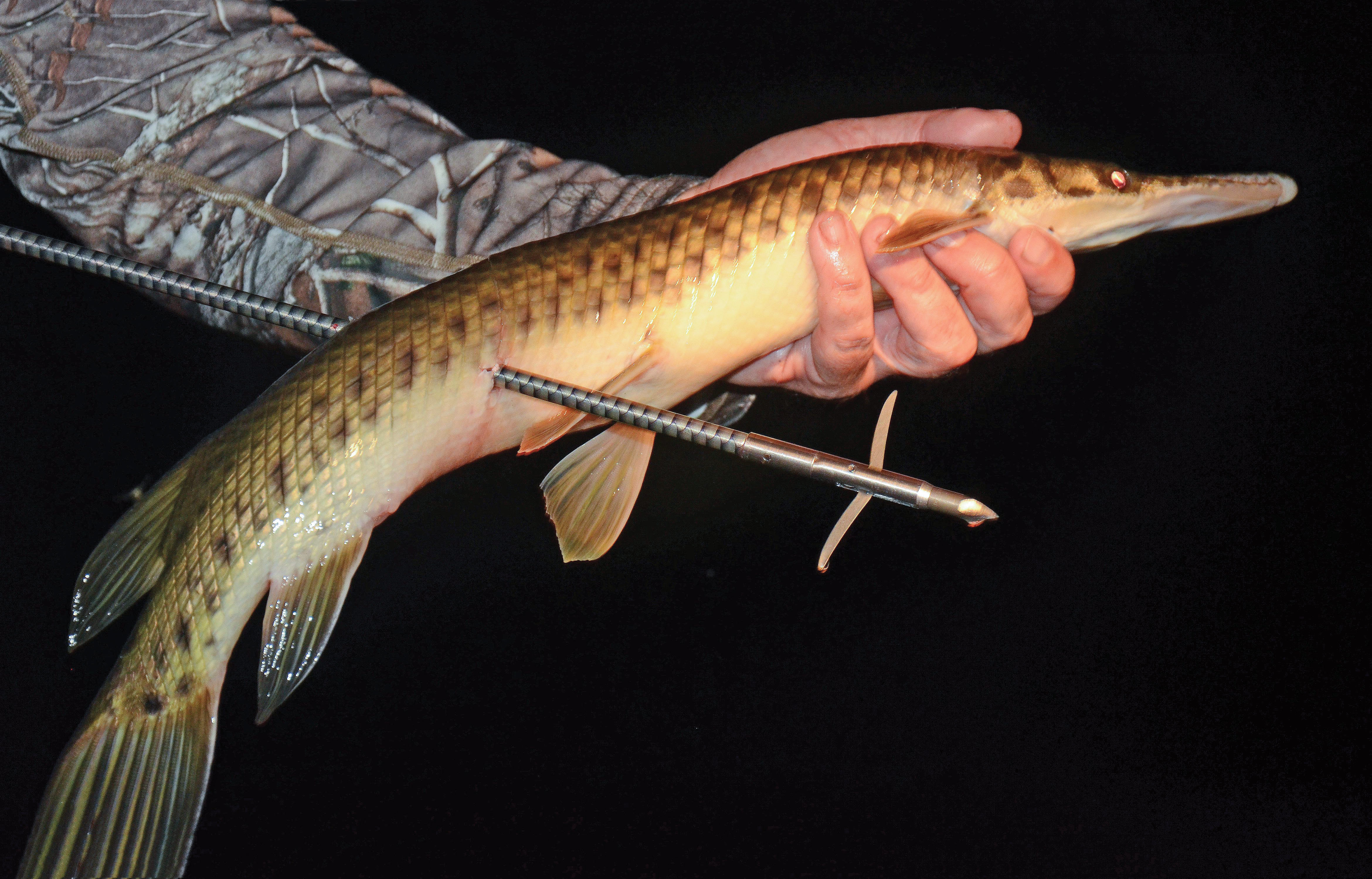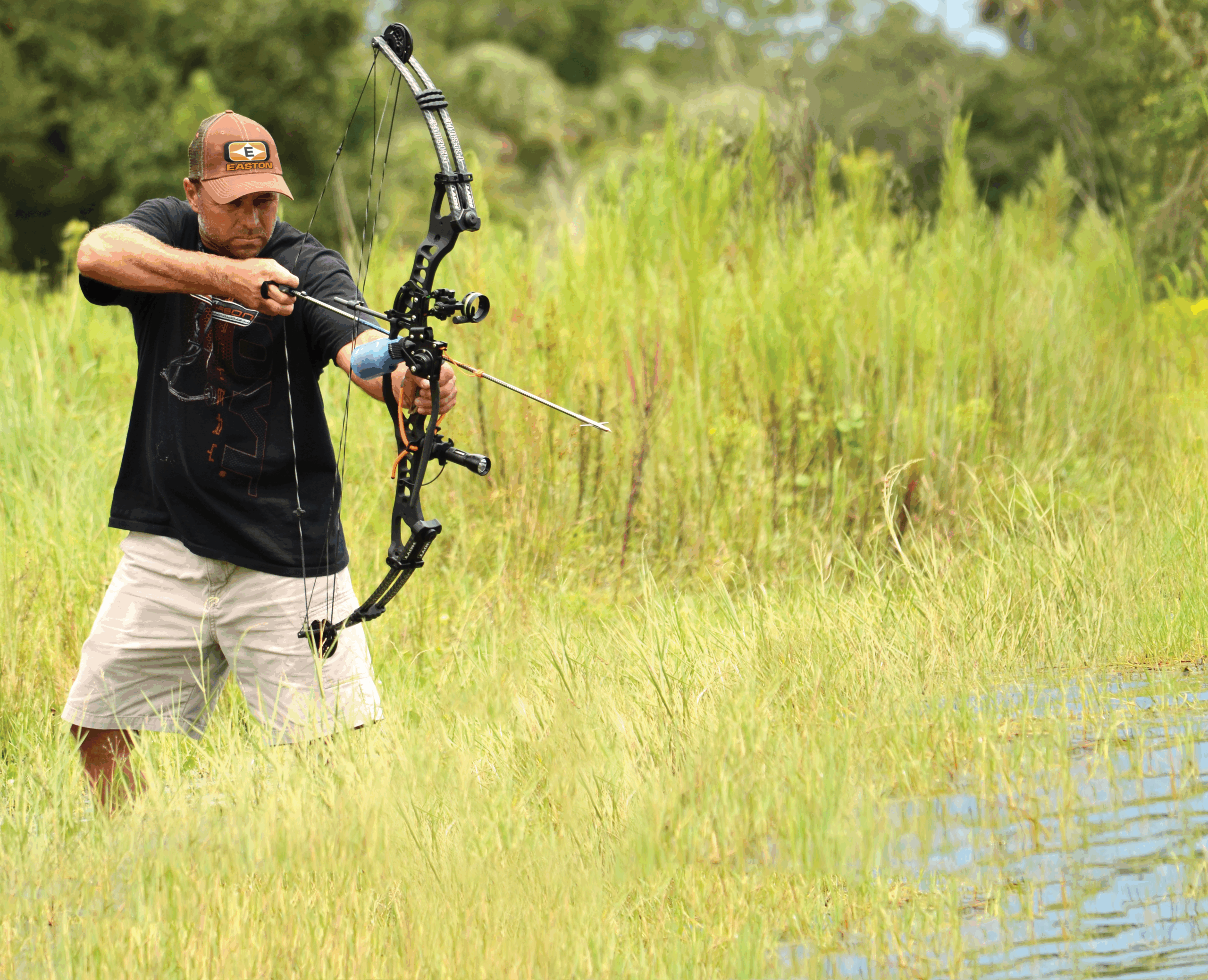If you’re not having fun bowfishing, maybe it’s time to take up knitting or work in the flower beds. How could anyone not enjoy bowfishing? Whether you’re in a boat with a fan and powerful bow lights or wading quietly through a flooded backwater, bowfishing is one of the coolest things to do if you like flinging arrows.
No one knows when the first arrow was fired at a fish. It likely occurred during caveman days after it was determined that a smaller spear could fly with the aid of a stick and sinew. Because archery is a worldwide activity, from the jungles of South America to the African plains and northern territories of Europe, Asia and North America, man has speared and arrowed fish, fowl and game for centuries.
It’s been close to 20 years that I’ve been bowfishing, and although I don’t go as often as I’d like, I love it every time I’m on the water. Even in summer when the temperature rises, nighttime on the lake is quiet (except for the boat’s giant fan and generator) and calm (except when a thrashing gar or huge buffalo comes over the side) and usually not humid (but still a mite warm).
It doesn’t take an expensive bow and arrows to get into bowfishing. You don’t need an eye-popping boat that would break the bank. A recurve bow, some fiberglass arrows and bowfishing points, and a properly rigged johnboat or even wading wet in summer can get it done. Interest in bowfishing continues to grow for freshwater and saltwater anglers throughout the country.
“I think it’s growing really big with the younger category due to a lot of efforts from bowfishermen trying to grow the sport and with the tournaments,” said Mark Land with Feradyne, which makes Muzzy Bowfishing gear. “I know in Kentucky, where I’ve shot three times this year, the banks are lined with kids with bows shooting fish. There were kids, parents, grandparents, and I think the biggest boom in that area has been the Asian carp invasion.”

Asian, or silver, carp have infiltrated the Mississippi and Tennessee rivers along with some of their tributaries. The giant invasive fish leap from the water when frightened by a boat motor or bowfishing fan. Bighead carp, another popular bowfishing species, also are found in the rivers.
Years ago, Land was one of the first guys I bowfished with, and what he told me then still applies today.
“Deer hunters maybe get one or two shots during a season if they’re going after a big buck, or maybe a few more if they’re shooting some does,” he said. “With bowfishing, you might shoot a couple of hundred times a night. It’s quick, you have targets and you’re drawing, shooting and doing it again and again.”
Easy to Get Started
For deer hunters wanting a little more shooting, bowfishing isn’t difficult to get into. If you don’t have an older bow, you can find one online or at an archery shop for a discount price. Old recurve bows work well, too. You don’t need sights, stabilizers, geegaws, high draw weights, wheels and cams or other deer hunting gear, because you’ll be shooting often, instinctively, and also getting things slimy, wet and banged around.
You’ll want some kind of closed-face fishing reel (such as a big Zebco 808) or bottle attached to your bow for your line. I prefer a reel for durability, although they’re heavier. Fiberglass arrows are tough, and you’ll need some points with reversible barbs. That makes it easy to remove the arrow from the fish. Simply unscrew the barb if need be.
There are other bowfishing items you can add, too, such as a gaff hook, a baton or small child’s baseball bat to, uh, pacify a big or flopping fish, and extra arrows, points and nocks. One great thing I like and have on my old recurve is the No-Glov Finger Savers. Instead of a release, glove or finger tabs, the No-Glov tabs attach directly to the string and can be set for your fingers. Just draw and release.
Don’t Be Wasteful With Your Fish
One of the most common refrains among bowfishermen is to properly dispose of your fish. If you bowfish a lot, you’ve seen or heard about “that pile of fish at the ramp” someone left there, often in a row after taking the hero photo with their phone camera.
And then instead of picking up the fish to dump in the garbage can, loading them up to take home or giving them to someone, they leave the fish there. It stinks, makes bowfishermen and outdoorsmen look bad, and is just flat out a bad deal. Do not be “that” guy or group leaving a mess at the boat ramp.

If you have a boat, take a big barrel, garbage can or something to hold the fish until you can get rid of them. Some anglers want fish to grind up as chum or catfish bait for trotlines or slat boxes. Asking around tackle shops might reveal a willing recipient.
How to Bowfish for Carp Species
Asian carp were brought into the United States to help fish farms cut down on algae, because the fish are filter feeders. After floods in some lower Mississippi River areas allowed the carp to escape into the river, it was only a matter of time until they began spreading and reproducing prolifically.
Now the leaping exotics are in the Mississippi, Illinois and Tennessee rivers, among others. Land said you can shoot them from a boat or bank, and because they’re spooked by noise, you can go after them during the daytime. Bighead carp are visible during the day, too, and their large size makes them easier to spot.
“All you need is a boat and motor to get them to jump, or fish below the dam when they’re generating water through the dam,” he said. “You can shoot from a boat or off the bank, whichever.
“I don’t care too much about silver carp, but I love shooting the bigheads. They average 20 to 40 pounds. Silvers are fun, but they’re so nasty and absolutely destroy your boat.”
What’s the Next Bowfishing Star?
Land said snakeheads got a little spotlight for a couple of years, but stingrays and other rays in shallow saltwater areas of the Atlantic, Pacific and Gulf of Mexico are hot bowfishing targets now.
“Stingrays are getting popular wherever they’re located,” he said. “Skates are a smaller species but are very popular to shoot, too. With either one, you want to shoot them in the forward middle portion. You don’t want to shoot the wing tips because they will tear off, and you don’t want to shoot toward the tail or stinger, because they’re hard to handle.”
Land said the Southern stingray can grow to more than 100 pounds, and the bluntnose and cownose also are popular.


